At Glowskinhub.com, we believe beauty isn’t just a look—it’s a feeling

Mastering the Layering of Skincare Actives
A well-crafted skincare routine is essential for achieving healthy, glowing Skin. One crucial aspect of this routine is the correct layering of skincare products. When done correctly, layering can significantly enhance the effectiveness of your skincare products.
The order in which you apply your skincare products can make a substantial difference in their absorption and overall impact. Understanding how to layer skincare actives can help you maximize their benefits and achieve the desired results.
Key Takeaways
- Understand the importance of layering in a skincare routine.
- Learn the correct order for applying skincare products.
- Discover how to maximize the benefits of your skincare actives.
- Find out how to create a personalized skincare routine.
- Achieve healthier, glowing Skin through effective layering.
The Science Behind Skincare Layering
The order in which you apply skincare products significantly impacts their efficacy, making it essential to grasp the underlying science. Skincare layering is a complex process that involves more than just applying multiple products; it’s about understanding how these products interact with each other and your Skin.
Why the Order of Application Matters
The sequence of product application can either enhance or diminish the effectiveness of your skincare routine. Applying products in the right order ensures that each active ingredient is absorbed properly, maximizing its benefits.
How Actives Penetrate the Skin
Different skincare actives penetrate the Skin at varying rates, influenced by their molecular structure and the formulation of the product. For instance, water-based products tend to penetrate more quickly than oil-based ones.
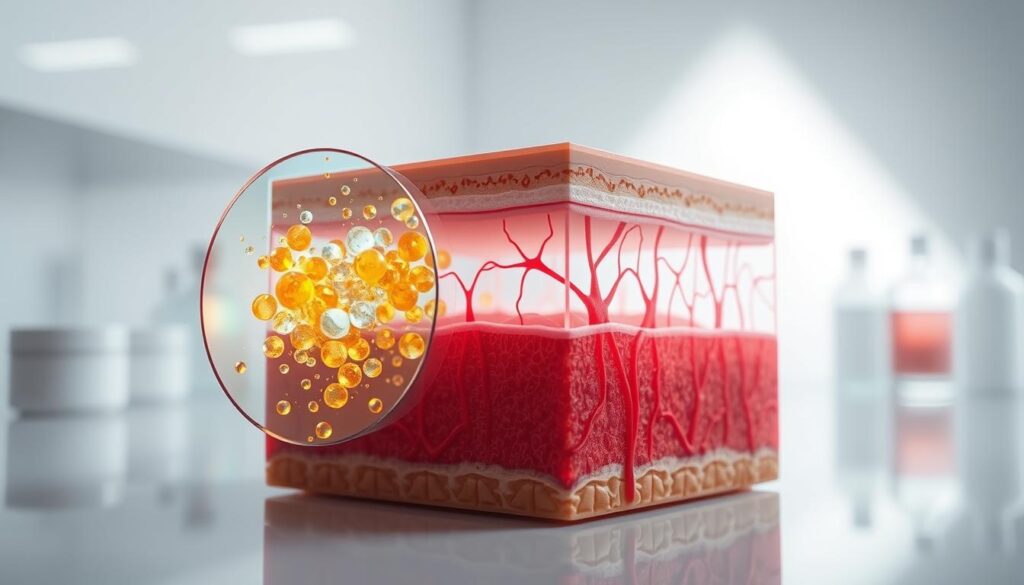
The Role of Skin pH in Product Efficacy
The Skin’s natural pH plays a crucial role in determining the efficacy of skincare products. Products that are too alkaline or acidic can disrupt the Skin’s barrier function, reducing their effectiveness.
| Product Type | pH Level | Effect on Skin |
|---|---|---|
| Alkaline Products | High pH | Disrupts Skin barrier |
| Acidic Products | Low pH | May cause irritation |
| pH-Balanced Products | Close to Skin’s natural pH | Optimal absorption and efficacy |
Understanding these factors is key to creating an effective skincare layering routine that maximizes product efficacy.
Understanding Different Types of Skincare Actives
To maximize the benefits of your skincare routine, it’s crucial to comprehend the different types of skincare actives. Skincare actives are the backbone of any effective skincare regimen, and their diverse formulations can significantly impact their efficacy.
Water-Based vs. Oil-Based Formulations
Skincare products can be broadly categorized into water-based and oil-based formulations. Water-based products are typically lightweight and absorb quickly, making them ideal for layering. On the other hand, oil-based products provide a barrier on the Skin’s surface, locking in moisture and protecting against environmental stressors.

Molecular Weight and Absorption Rates
The molecular weight of an active ingredient plays a significant role in its absorption rate. Lower molecular weight ingredients penetrate the Skin more easily, while higher molecular weight ingredients tend to stay on the surface, providing a barrier. Understanding this can help you layer products more effectively.
Active Ingredient Concentrations
The concentration of active ingredients is another critical factor. Products with higher concentrations of actives are generally more effective but can also increase the risk of irritation. It’s essential to balance efficacy with tolerance when layering actives.
- Start with lower concentrations and gradually increase as your Skin becomes more tolerant.
- Be aware of the cumulative effect of layering multiple products with high active concentrations.
By understanding these different aspects of skincare actives, you can create a more effective layering routine that addresses your specific Skin concerns.
The Fundamental Rule: Thinnest to Thickest
Understanding the fundamental rule of layering skincare products is key to maximizing their benefits. This rule is based on applying products from thinnest to thickest, ensuring that each layer is absorbed effectively into the Skin.
Texture-Based Layering Principles
The principle behind texture-based layering is simple: apply products in order of their viscosity, starting with the lightest, most watery textures and progressing to the thicker, more occlusive products. This ensures that active ingredients are delivered effectively into the Skin.
For example, if you’re using a Serum that’s more watery, it should be applied before a thicker moisturizer. This order makes sense because the Serum can penetrate the Skin more easily when applied first, while the moisturizer can then lock it in and provide a barrier on the Skin’s surface.

Exceptions to the Rule
While the thinnest to thickest rule is a good guideline, there are exceptions based on the specific products and their active ingredients. For instance, some products, like exfoliating toners, may need to be applied at a specific point in the routine to be effective.
Wait Times Between Applications
Allowing adequate wait times between applications is crucial for ensuring that each product is fully absorbed before the next is applied. A general rule of thumb is to wait about 30 seconds to a minute between applications.
| Product Type | Typical Wait Time | Reason |
|---|---|---|
| Serums and Essences | 30 seconds | Allows for absorption into the Skin |
| Moisturizers and Oils | 1-2 minutes | Helps lock in previous layers |
| Sunscreens | Immediate application after moisturizer | Ensures SPF coverage |
By following the fundamental rule of layering skincare products from thinnest to thickest and being mindful of wait times, you can optimize your skincare routine for better results.
How to Layer Skincare Actives: The Complete Guide
To achieve the best results from your skincare routine, understanding how to layer skincare actives is crucial. Layering skincare products is a step-by-step process that, when done correctly, can significantly enhance the effectiveness of your routine.
Cleansers and Toners
The foundation of any skincare routine is a good cleanser. Cleansers remove dirt, oil, and makeup, preparing your Skin for subsequent products. Following cleansing, toners can help balance your Skin’s pH and remove any remaining impurities.
Essences and Serums
Essences are lightweight, hydrating products that deliver active ingredients to the Skin. They are applied after toners and before serums. Serums are concentrated formulations that target specific Skin concerns such as aging, acne, or hyperpigmentation.
Treatments and Ampoules
Treatments and ampoules are potent products that address specific Skin issues. Treatments can include exfoliants, masks, and spot treatments, while ampoules are highly concentrated serums that provide an intense dose of active ingredients.
Moisturizers and Oils
Moisturizers help lock in previous layers and provide hydration, while oils can add an extra layer of protection and nourishment. The choice between moisturizer and oil depends on your Skin type and needs.
Sunscreens and Specialty Products
Sunscreens are essential for daytime routines, protecting your Skin from UV damage. Specialty products can include eye creams, lip balms, and other targeted treatments that address specific concerns.
| Product | Function | Layering Order |
|---|---|---|
| Cleanser | Removes dirt and impurities | 1 |
| Toner | Balances Skin pH | 2 |
| Essence | Delivers active ingredients | 3 |
| Serum | Targets specific Skin concerns | 4 |
| Moisturizer/Oil | Hydrates and protects | 5 |
| Sunscreen | Protects from UV damage | 6 (daytime only) |
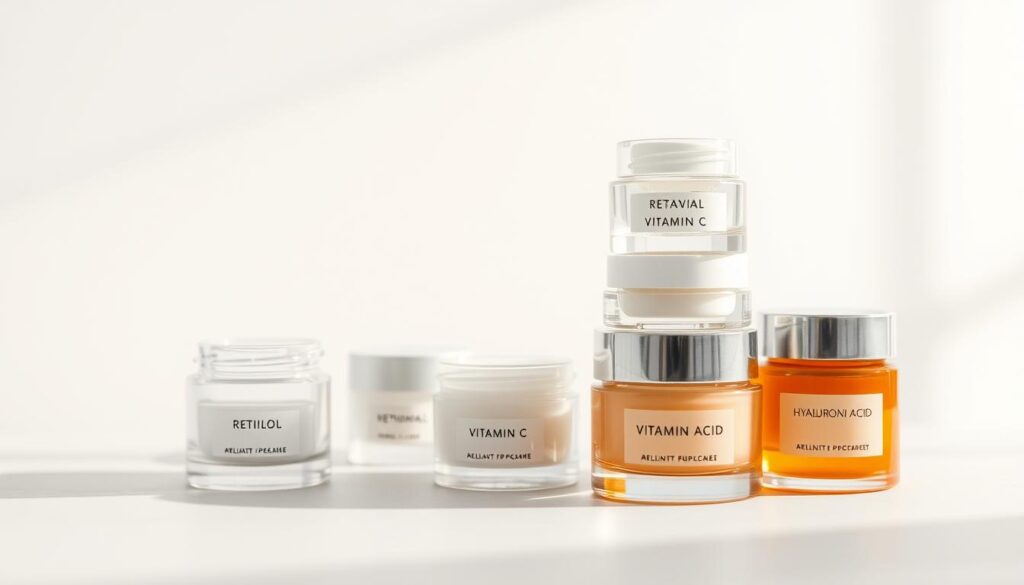
By following this layering guide, you can create a skincare routine that is tailored to your Skin’s needs, maximizing the effectiveness of each product and achieving healthier, more radiant Skin.
Morning Skincare Routine: Layering for Day Protection
A morning skincare routine that incorporates the right layering technique can significantly enhance your Skin’s protection and appearance throughout the day. The key to an effective morning routine lies in understanding how to layer products to achieve maximum benefit.
Antioxidants and Vitamin C
Begin your morning routine with products rich in antioxidants and Vitamin C, which help protect the Skin from environmental stressors and promote collagen production. These ingredients are most effective when applied directly after cleansing.
Hydrating Ingredients
Following antioxidants, apply hydrating ingredients such as hyaluronic acid to lock in moisture and provide a smooth canvas for subsequent products. Hydration is crucial for maintaining Skin elasticity and suppleness.
SPF Integration
SPF integration is a critical step in the morning skincare routine. Apply a broad-spectrum sunscreen with an SPF of at least 30 as the final step in your skincare layering or under your makeup. This protects the Skin from UV damage and prevents premature aging.
Makeup-Compatible Layering
For those who wear makeup, ensuring that your skincare products are compatible with your makeup is essential. Use lightweight, non-greasy formulations that won’t interfere with makeup application. A well-layered skincare routine can enhance the wear and appearance of your makeup.
| Product | Key Ingredient | Benefit |
|---|---|---|
| Antioxidant Serum | Vitamin C | Protects against environmental stressors |
| Hydrating Essence | Hyaluronic Acid | Locks in moisture |
| Sunscreen | Zinc Oxide | Provides broad-spectrum UV protection |
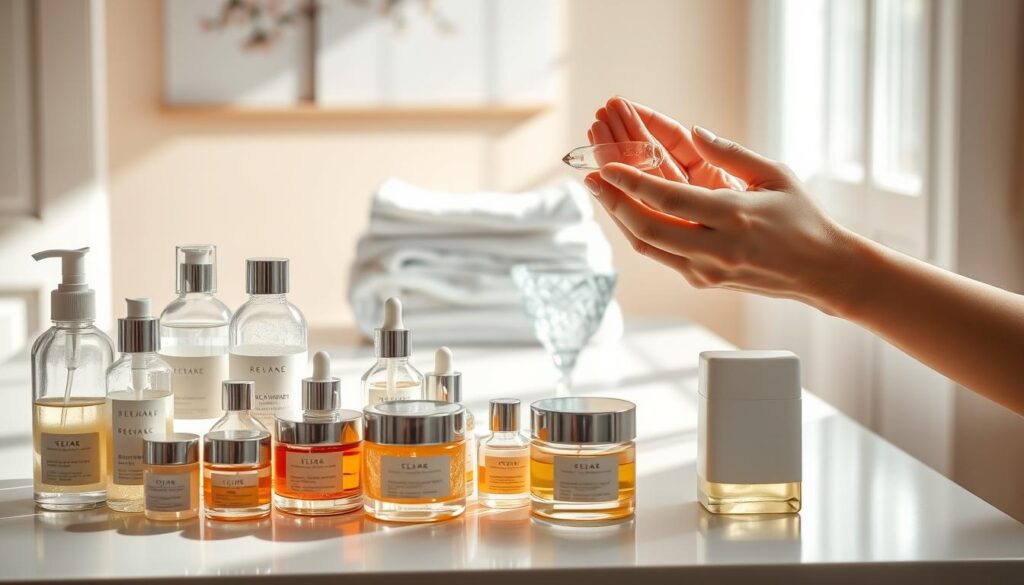
Evening Skincare Routine: Layering for Overnight Repair
To maximize overnight Skin repair, it’s essential to understand how to layer skincare actives correctly in the evening. This involves selecting the right products and applying them in an order that enhances their effectiveness.
Exfoliants and Retinoids
Exfoliants, such as alpha-hydroxy acids (AHAs) and beta-hydroxy acids (BHAs), help remove dead Skin cells, while retinoids work to regenerate Skin cells and reduce signs of aging. When layering these products, start with exfoliants to clear the Skin, followed by retinoids to stimulate renewal.
Peptides and Growth Factors
Peptides and growth factors are powerful ingredients that can be layered to enhance collagen production and Skin elasticity. Apply peptides first to stimulate collagen, then growth factors to support Skin regeneration.
Occlusive Ingredients
Occlusive ingredients, such as petrolatum or dimethicone, help lock in previous layers and prevent moisture loss. Apply these last to seal in the active ingredients and support the Skin’s barrier function.
Overnight Treatments
Overnight treatments can be highly effective when layered correctly. Look for products containing hyaluronic acid, ceramides, or niacinamide, which help hydrate and repair the Skin while you sleep.
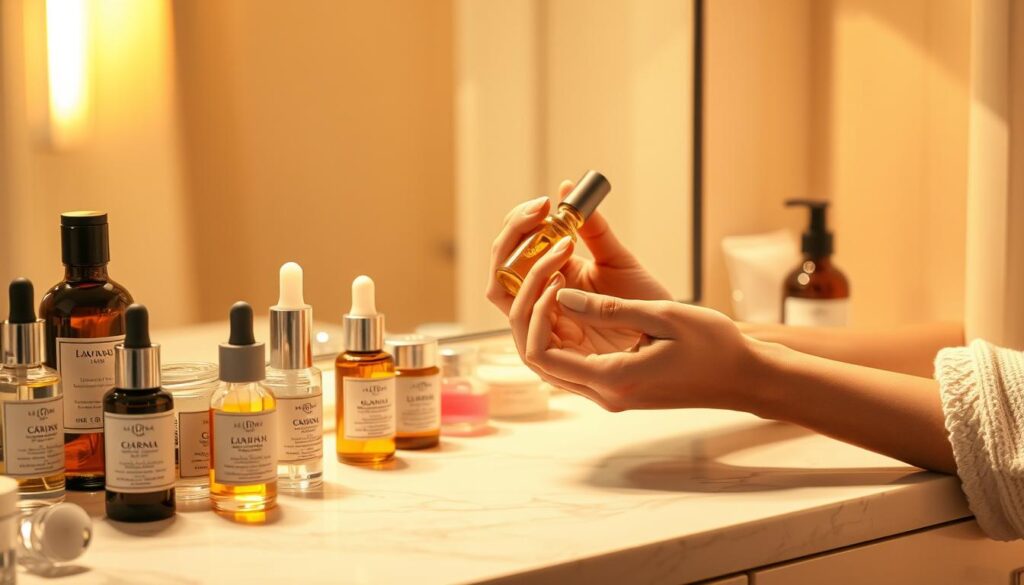
| Product Type | Example Ingredients | Layering Order |
|---|---|---|
| Exfoliants | AHAs, BHAs | 1st |
| Retinoids | Retinol, Retinoic Acid | 2nd |
| Peptides and Growth Factors | Acetyl Hexapeptide, EGF | 3rd |
| Occlusive Ingredients | Petrolatum, Dimethicone | Last |
By understanding how to layer these products effectively, you can create an evening skincare routine that maximizes overnight repair and leaves your Skin looking healthier and more radiant.
Powerful Combinations: Actives That Work Well Together
Certain skincare actives work synergistically to enhance their benefits. By combining the right actives, you can address multiple Skin concerns simultaneously and achieve better results.
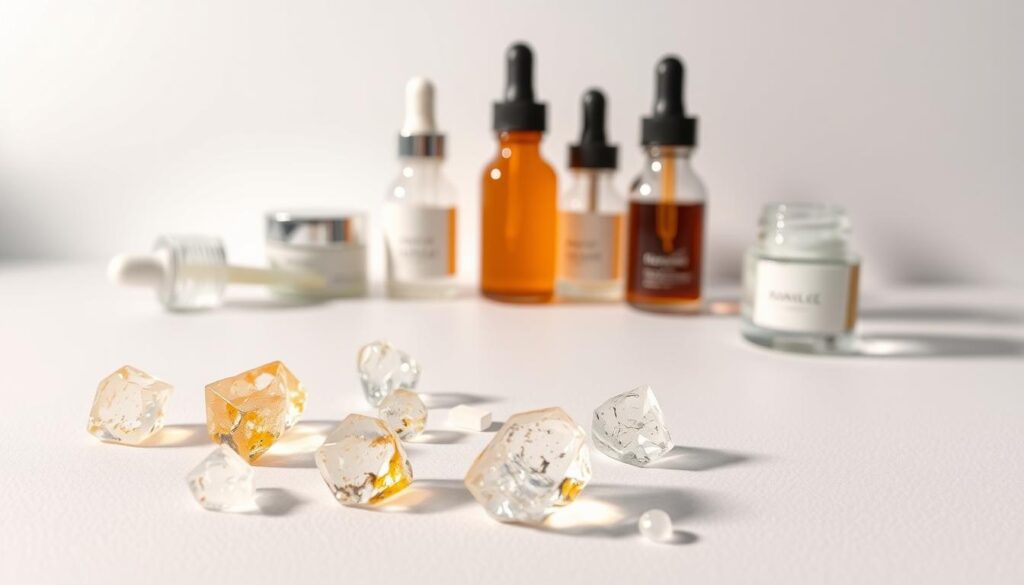
Vitamin C and Ferulic Acid
Vitamin C is a potent antioxidant that brightens the Skin and protects it from environmental stressors. When paired with ferulic acid, its stability and effectiveness are significantly enhanced, providing even greater protection against free radicals.
Niacinamide and Hyaluronic Acid
Niacinamide is known for its ability to improve Skin elasticity and reduce inflammation, while hyaluronic acid provides intense hydration. Together, they create a powerful combination that not only hydrates the Skin but also improves its overall texture and tone.
Retinol and Peptides
Retinol is a derivative of vitamin A that promotes cell turnover and collagen production, reducing the appearance of fine lines and wrinkles. When combined with peptides, which stimulate collagen production, the anti-aging benefits are amplified, resulting in smoother, more youthful-looking Skin.
AHAs/BHAs and Hydrating Ingredients
AHAs (Alpha Hydroxy Acids) and BHAs (Beta Hydroxy Acids) are exfoliants that help remove dead Skin cells and unclog pores. Pairing them with hydrating ingredients like hyaluronic acid or glycerin can mitigate potential irritation and dryness, ensuring a more balanced and effective exfoliation process.
By understanding which skincare actives work well together, you can create a customized routine that addresses your specific Skin concerns and maximizes the benefits of each product.
Ingredient Conflicts: Actives That Shouldn’t Mix
While layering skincare actives can be beneficial, certain combinations can lead to adverse reactions. Understanding which ingredients conflict is crucial for a safe and effective skincare routine.
Retinoids and AHAs/BHAs
Combining retinoids with alpha-hydroxy acids (AHAs) or beta-hydroxy acids (BHAs) can increase the risk of irritation, including redness and dryness. It’s generally recommended to alternate their use or start with lower concentrations.
Vitamin C and Niacinamide Debates
There’s ongoing debate about the compatibility of vitamin C and niacinamide. Some studies suggest they can be unstable when combined, potentially reducing their efficacy. Patch testing is advised when using these ingredients together.
Benzoyl Peroxide Interactions
Benzoyl peroxide can interact with certain actives, like retinoids, by oxidizing them and reducing their potency. Using benzoyl peroxide in the morning and retinoids at night can help mitigate this issue.
Multiple Acid Combinations
Layering multiple acids (AHAs/BHAs) can lead to over-exfoliation, causing irritation and compromising the Skin’s barrier function. A careful approach to introducing these products is necessary to avoid adverse effects.
| Ingredient Combination | Potential Issue | Recommendation |
|---|---|---|
| Retinoids + AHAs/BHAs | Increased irritation risk | Alternate use or lower concentrations |
| Vitamin C + Niacinamide | Potential instability | Patch test |
| Benzoyl Peroxide + Retinoids | Reduced retinoid efficacy | Use at different times |
Customizing Your Layering Routine for Different Skin Concerns
Tailoring your layering routine to address specific Skin issues is crucial for achieving optimal skincare results. Different Skin concerns require unique approaches to layering skincare actives.
Acne-Prone Skin
For acne-prone Skin, it’s essential to focus on products containing salicylic acid or benzoyl peroxide. Layering a toner with salicylic acid followed by a spot treatment containing benzoyl peroxide can be highly effective. Be cautious not to over-layer, as this can lead to dryness and irritation.
Aging Skin
Aging Skin benefits from layering products rich in antioxidants and peptides. Start with a vitamin C Serum to brighten and protect the Skin, followed by a peptide-rich treatment to stimulate collagen production. Consistency is key when addressing signs of aging.
Hyperpigmentation
For hyperpigmentation, layering products with niacinamide and vitamin C can help reduce the appearance of dark spots. Begin with a niacinamide Serum to improve Skin elasticity and reduce inflammation, then apply a vitamin C Serum to brighten the Skin.
Sensitive and Reactive Skin
Sensitive Skin requires gentle, soothing products. Layering a calming toner with a moisturizer can help hydrate and protect the Skin barrier. Avoid harsh actives like AHAs/BHAs and retinoids, which can irritate sensitive Skin.
| Skin Concern | Recommended Actives | Layering Tips |
|---|---|---|
| Acne-Prone | Salicylic Acid, Benzoyl Peroxide | Layer toner with salicylic acid, then spot treat with benzoyl peroxide |
| Aging | Vitamin C, Peptides | Layer vitamin C Serum followed by peptide-rich treatment |
| Hyperpigmentation | Niacinamide, Vitamin C | Layer niacinamide Serum, then vitamin C Serum |
| Sensitive | Calming Ingredients | Layer calming toner with moisturizer |
Common Mistakes to Avoid When Layering Actives
The art of layering skincare products is nuanced, and avoiding common pitfalls is key to achieving the desired results. Many of us enthusiastically layer product upon product, hoping to address multiple Skin concerns at once. However, without a thoughtful approach, this can lead to inefficacy or even adverse reactions.
Using Too Many Products at Once
One of the most common mistakes is over-layering. Using too many products simultaneously can overwhelm the Skin, potentially causing irritation or clogged pores. Simplifying your routine and focusing on a few key products can be more effective.
Not Allowing Proper Absorption Time
Another critical error is not waiting long enough between applications. Allowing products to absorb properly ensures that each active ingredient can work effectively without being diluted or blocked by subsequent products.
Ignoring Skin Reactions and Irritation
It’s crucial to pay attention to how your Skin reacts to different products and combinations. Ignoring initial irritation can lead to more severe reactions over time. If you notice any adverse effects, adjust your routine accordingly.
Inconsistent Application
Consistency is key when it comes to skincare. Irregular application can disrupt the Skin’s natural balance and hinder the effectiveness of your products. Establishing a consistent routine helps in achieving and maintaining optimal Skin health.
As skincare expert Dr. Joshua Zeichner once said, “The key to a successful skincare routine is not just about the products you use, but how you use them.” By avoiding these common mistakes, you can maximize the benefits of layering skincare actives and achieve healthier, more radiant Skin.
Conclusion: Creating Your Perfect Skincare Layering Strategy
Mastering the art of layering skincare actives is a journey that requires patience, consistency, and a deep understanding of your Skin. By following the guidelines outlined in this article, you can create a skincare layering strategy that addresses your unique Skin concerns and needs.
To develop a perfect skincare routine, it’s essential to understand how different actives work together and how to layer them effectively. By combining the right products in the right order, you can maximize their benefits and achieve the best possible results.
By adopting the best skincare practices and being mindful of your Skin’s reactions, you can refine your routine over time and enjoy a healthier, more radiant complexion. Start experimenting with different layering combinations today and discover the transformative power of a well-crafted skincare routine.





